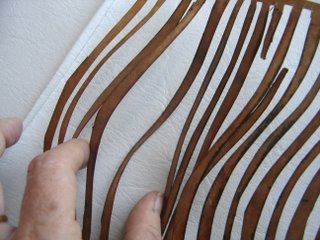
These are my studio notes on creating a stencil with paper and varnish. It is a process that I have devised for myself .
this is for a handcut handdrawn stencil
step one: design
materials: paper, pencil, ruler and erasor, pen, brush and ink
- start with a sheet of heavy watercolour paper [300gsm]
- mark out the outline of the outer edge of the image [eg 4 x 6 ins]
- then add a wide border to strengthen the stencil. The border shuld be around a third of the image size, between 3 and 10cms depending on paper size.

insufficient border
- If there are alignment or registration problems with using the stencil in conjunction with other stencils , consider and resolve them now.
- draw out your design in pencil
- there are physical limitations to how small or large the holes can be. You have to decide where the bridges that join the shapes go. Its similar to planning the blacks and the whites in linocut, with the added complication that everything must join together with structural integrity.

too much lateral movement
- paint in the 'black' areas where the paper will be removed. Erase construction lines. Check the design works. Look at it from a distance. It should be easily read from across the room.
- scan photocopy or otherwise record the design
materials: cutting pad, sharp knife, ruler, lightbox
- you need a sharp knife that you can use like a pencil. It is essential that the blade is very sharp so disposable blade knives are ideal.
- cut the smallest holes first and the fiddly bits. This is to make full use of the paper's strength for as long as possible. The more you remove, the more fragile the stencil becomes. Cut 'away' from fragile bridges.
- cut the big holes last
- use a light box or the sunlit sky to view the stencil at regular intervals to check for errors.
- you can make repairs with paper tape. [ paper address labels are good] Tape the stencil both sides, then cut the tape to match the stencil.
- when you have finished place it against your black book and check it out.
materials: shellac flakes, metholated spirits, jam jar, plastic spoon, cheap paint brush, newspapers.
- cover your work surface with newspaper; prepare a seperate drying area also covered with newspaper
- mix the shellac flakes with the meths in the jam jar. Stir until it dissolves. Try 1:4 shellac to meths. Play with the consistencies, until you get a mix that is right for you.
- You don't need to use it all, keep some extra flakes in reserve to thicken the mixture if required.
- Shellac will thicken when stored, just add more meths to thin. Store with tight lid on.
- Place the stencil on the newspaper and coat both sides with shellac. Dry on prepared newspaper. Repeat several times.
- Clean the brush with meths, then soap and water.
- The shellac soaks into the paper and waterproofs it. It also strengthens it. The paper resembles a hard thin waterproof card.
materials: paper, paint etc

- mark the registration marks on the back of the stencil
- tape the paper into place, turn stencil over.
- proof the stencil
- check the design, recut or repair any errors
- keep re-proofing the stencil until you are satisfied.
- the stencil is now ready for use
No comments:
Post a Comment